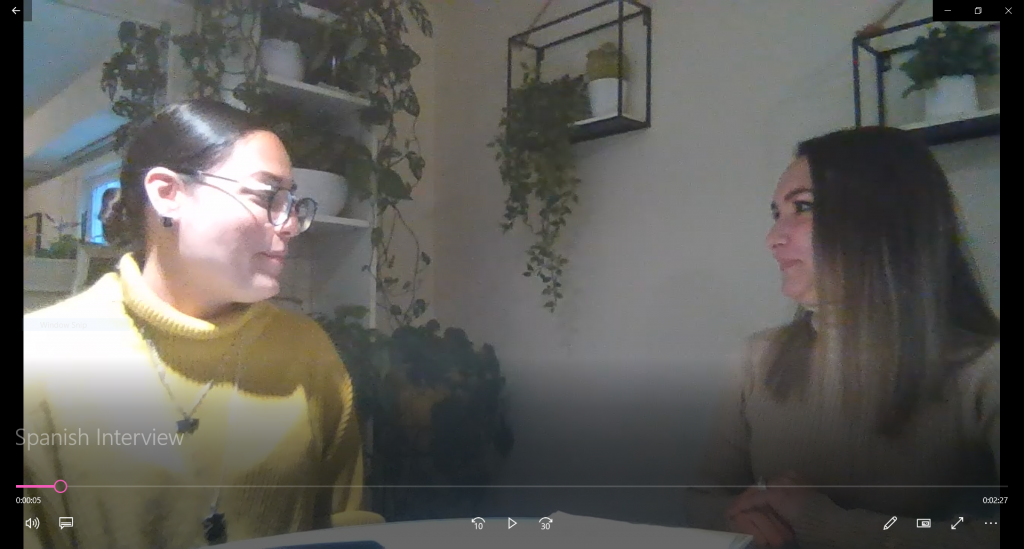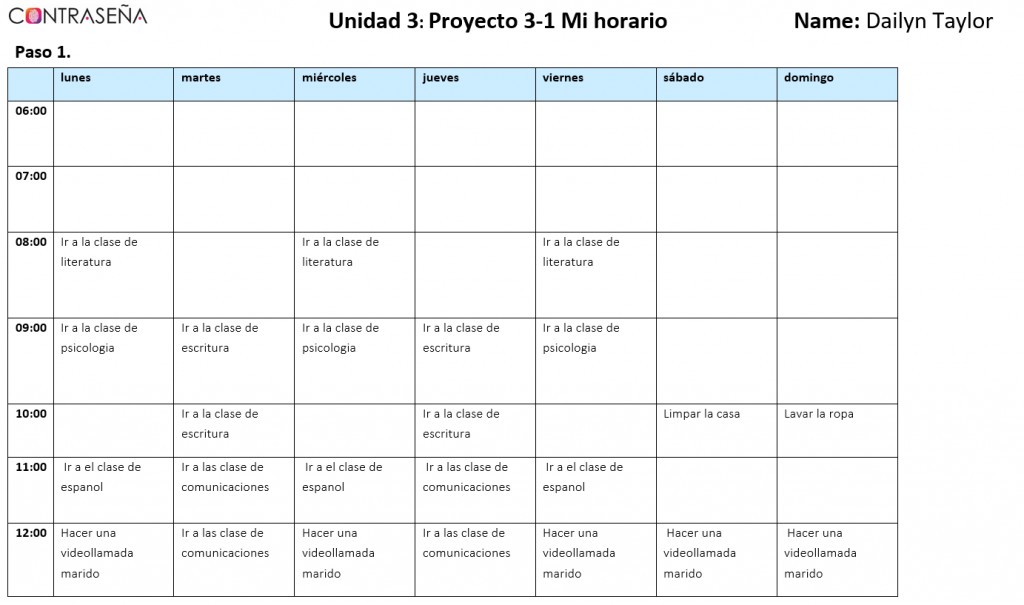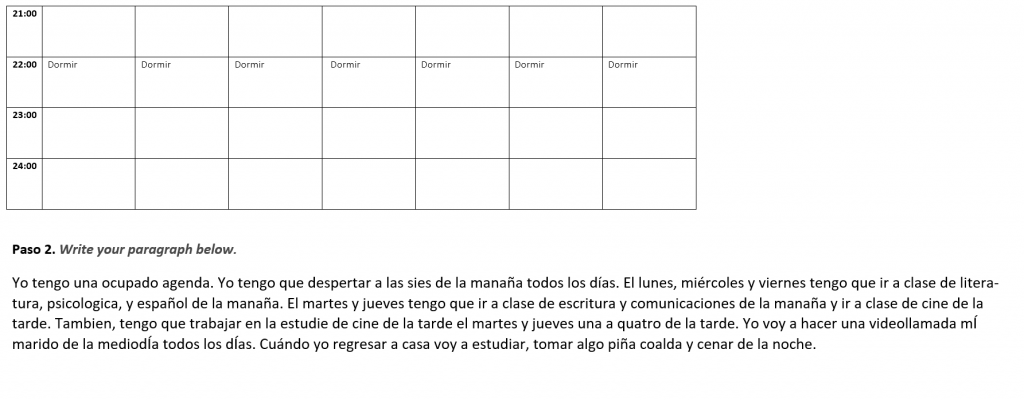Exploring Culture
In class we studied cultural perspectives by looking at the differences in people, this included college students, people’s schedules, things people did for fun, and buildings around campus. Professor Garcia taught us through powerpoint instruction. On these powerpoints included pictures, videos, lines of text. I think the pictures with text helped the most. The videos were hard to understand, because I could not understand the language as quickly as they were speaking.
The tools explained above helped me better understand the values and attitudes in the Hispanic culture because it displayed the thoughts and ideas of a person with a Hispanic background, as well as showing a picture of themselves or of the topic that is being discussed. These practices challenged my worldview by not only giving the facts of the culture, but also giving the story behind the members of the culture. I had to compare my own actions and livelihood to theirs, and evaluate the reasoning behind these actions and try to understand their point of view. These different perspectives revealed the power a country has on it’s people and on the society you live in. It caused me to realize a misconception I had that was college stay in dorms in Hispanic countries, they do not. This caused me to view the world from a different perspective because as American college students we have the ability and privilege of being able to stay in dorms where we are going to school. In Hispanic countries they do not have this luxury, and they either stay home and travel to school or move in with someone near the school. I never knew this before hand, so it’s interesting what American’s take for granted and don’t fully appreciate.
Engaging in Communities
It is important to engage in your immediate community because those people will be the ones engaging with you during discussions in class. When learning Spanish, it is important to practice speaking it as much as possible, so practicing with the people around you is the most efficient way of completing that task. They should be practicing the same lessons as yourself, so practicing in Spanish benefits both parties. Also, getting to know classmates is good for social experiences as well. Learning what others interests are and what hobbies they have can help you know if you can make friends and talk to some about more than just Spanish. It is important to engage in your global community because understanding the cultures of others not only good to strengthen your human communication skills, but also because it will help you understand yourself and your cultural influence better.
While participating in my immediate community I’ve talked to many individual and made a couple friends. I worked with Daniela on the video making project and have talked to her some outside of class. Also, I have talked to Jodi many times and commented on many of her assignments. I think being able to talk to my classmates during my assignments has allowed me to become more comfortable around them and assisted me with learning Spanish.
Interpersonal Communication
I remember one assignment where we had to interview a Hispanic person about themselves and things relating to friends and school. It was difficult for me to find a person to interview, however I was able to interview my husbands coworkers wife. I greatly enjoyed the assignment, I had a fun time interviewing my subject and spoke to her for a while afterwards. I feel like this could continue to help me in Spanish. We also had an assignment where we had to make a video of buildings we go to and describe them. I slightly struggled with this assignment, mainly because of the multiple large uncommon words I encountered. But I do think it was an interesting assignment to complete.
I have grown from the Spanish interview because I now have the confidence to speak Spanish , as well as speak it to a Hispanic person. From the Spanish video assignment I have grown because I had to write down details about each place. I have a connection with these places and had to speak about them in Spanish multiple times. Now I can speak about things I do and how I feel about places in my life. What was difficult was remaining confident while speaking. When I would start faltering in my wording I got worried I wasn’t saying the words right and that I was going to slow. However, I had to learn to keep powering through and putting the words together, I can always adjust how I pronounce something, but I need to focus on structuring the sentences together. I would say what I excelled at was quickly grouping pieces of information together to help me understand the material discussed in class. I continued to struggle with pronunciation, however, I excelled and sentence structure and verb endings. I definitely need to practice the material more often. If I practiced both writing and speaking I could excel at all I am given.

Presentational Speaking
I remember in the beginning of the semester we had to spell our name out loud in Spanish. We have also had two interviews with the Professor. In these interviews we spoke about our schedules and what we know about our friends and people we admire. My first interview went really well, I studied a lot and prepared over spring break, I talked about my schedule, things I had to do and liked to do, as well as what time I did my activities. However, my second interview did not go well. I did not prepare or study beforehand, so I did not know what the Professor was asking me.
When I had to spell my name out loud in Spanish my challenge was making sure I pronounced the letters correctly. I overcame that challenge by creating a story for the pronunciations in my head. When you picture something it allows you to remember something more quickly. In my first interview my challenge was remembering how to say everything I did in my schedule. I have a busy schedule and it starts at 6 am and doesn’t end until 10 pm, so there was a lot to remember. However, my schedule is repetitive, so having to repeat what I was doing multiple times allowed for me to remember it better. My second interview was not good at all, I did not study or prepare. However, afterwards I went over the content and understood where I struggled at and why.
Presentational Writing
This semester we had to create a social media profile in Spanish. We detailed our name, age, birthday, qualities, hobbies, and education information. We also included a picture or video and a paragraph where we described ourselves. We then commented on our classmates profiles. Another assignment we completed was creating a detailed schedule of our week, where we laid out the activities we do on which day and at what time.
The assignment where we had to create a social media profile in Spanish allowed me to grow because I had to ponder a lot about my characteristics and qualities. Then after I decided on these qualities I had to explain it to others in Spanish, this allowed me to improve my grammatical and writing skills. The easy part was filling out the profile because it was answering the blanks, however, the paragraph was more difficult because I had to write multiple sentences and make sure it sounded correct when translated to Spanish. I overcame these difficulties by answering questions in Spanish when asked in class. This allowed me to practice what I was going to write for my paragraph, as well as remember it for the next day in class. Next was the assignment where we had to create our schedules’. This assignment helped me grow because I was able to recognize the activities I do on a daily basis and learn their Spanish translation. This allowed me to learn the days of the week, times of the day, and activities that I have to do and want to do. The easy part of this assignment was labeling the schedule with the activities I do, this is because all I had to do was translate the activity to Spanish and then write it in the schedule. However, the difficult part was writing out an explanation of my schedule because I had to remember the order of the structure with the verb, time, and activity. I overcame this difficulty by going over the activities from previous classes and analyzing the structure of those sentences, and related them to my own circumstances.



Interpretive Listening
The interpretive listening activities we completed this semester included listening to a speaker pronounce a letter of the alphabet in Spanish and us having to interpret what letter it was. We also did this numbers and time, for numbers we would listen to the speaker say a number in Spanish and we would identify the number they spoke, the same thing for time. We would also have to answer questions in Spanish that we listened to in Spanish.
What was challenging for me was having to memorize all the different numbers and times, but also memorize their pronunciations as well. I overcame this difficulty by writing out all the letters, numbers, words, and vocabulary in English, then Spanish, and then its pronunciation. This assisted me when studying and while working in class. What I found most interesting was the similarity between English, Spanish, and French. The French language has similar pronunciations to Spanish, which helped me significantly when studying the Spanish alphabet. My take away from these listening experiences is that it is very helpful when learning Spanish. Understanding how to day the words is one thing, but to also understand it when it is being spoken to you is another. This allows for a deeper understanding of the language. With each activity I have grown in my memorization of the vocabulary and familiarization of the language.
Interpretive Reading
The interpretive communication activities we read in class included reading other classmates assignments and having to reply to them, having to read questions in Spanish and respond to them in Spanish, and having to read paragraphs and determine which words belong in which blank spot. These assignments included reading paragraphs from other students, having to comprehend a paragraph and use context clues to infer the meanings of words, and having to determine meaning based on grammar and context.
What was challenging for me was trying to determine which sentence anonymous words belonged in. I would translate them to English, and then understand the sentences in English, but would still have difficulty determining which word worked best in which sentence. I overcame this difficulty by paying attention to context clues in the sentence and process of elimination. In Spanish words are masculine or feminine, singular or plural, have different endings according to their verbs, so this allows me to narrow down which word would grammatically work in the sentence. What I found most interesting was that I had such a difficult time with it, I do struggle with grammar and comprehension in English, so to see it also this way in Spanish is disappointing. My takeaways from the readings are that it is difficult to interpret what someone says when you are reading it. Many words can a different meaning and without body language, context, or tone it is difficult to determine exactly what is being said. I have grown with each assignment by studying how others structure their sentences in Spanish and learning off of them.